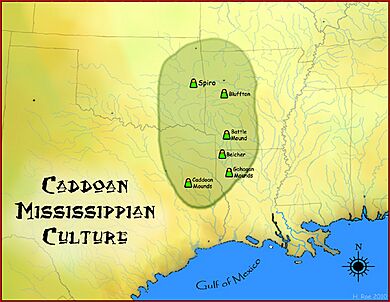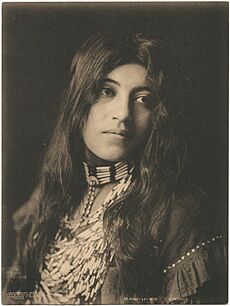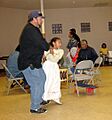Caddo facts for kids
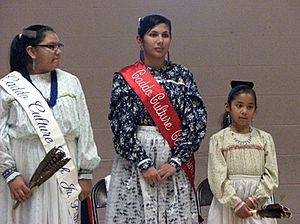
Caddo Nation citizens, members of the Caddo Cultural Club, Binger, Oklahoma, 2008
|
|
| Total population | |
|---|---|
| approximately 6,300 | |
| Regions with significant populations | |
| Oklahoma, United States (formerly Arkansas, Louisiana, and Texas) |
|
| Languages | |
| Dialects of Caddo and English | |
| Religion | |
| Ghost Dance, Native American Church, Christianity | |
| Related ethnic groups | |
| Pawnee, Wichita, Kichai, Arikara Caddo Confederacy: |
The Caddo people are an important Native American group. Today, they are known as the Caddo Nation of Oklahoma. Their main office is in Binger, Oklahoma. The Caddo people speak the Caddo language.
Long ago, the Caddo Confederacy was a group of Native American tribes. They lived in what is now northeast Texas, west Louisiana, southwestern Arkansas, and southeastern Oklahoma. Before Europeans arrived, they were part of the Caddoan Mississippian culture. This culture built large earth mounds between 800 and 1400 CE. In the early 1800s, Caddo people were forced to move to a reservation in Texas. Later, in 1859, they were moved again to Indian Territory.
Contents
Caddo Government and Culture
The Caddo Nation of Oklahoma used to be called the Caddo Tribe of Oklahoma. Their government has an eight-person council. This council is chosen by election and has a chairperson.
About 6,000 people are part of the Caddo Nation. More than 3,000 of them live in Oklahoma. To join the Nation, a person needs to show they have at least 1/16 Caddo family history.
The Caddo Nation works hard to keep its culture strong. They have a summer culture camp for children. Groups like the Hasinai Society and Caddo Culture Club teach Caddo songs and dances. This helps pass their traditions to new generations. The Kiwat Hasinay Foundation helps save and use the Caddo language.
Ancient Caddo History
Archaeological Discoveries
Experts believe the Caddo people came from older groups. These groups lived in Arkansas, Louisiana, Oklahoma, and Texas between 200 BCE and 800 CE. The Wichita and Pawnee tribes are also related to the Caddo. This is because they all spoke Caddoan languages.
Around 800 CE, these groups started to form the Caddoan Mississippian culture. Some villages became important centers for ceremonies. Leaders guided the building of large earth mounds. These were used as temples and homes for important people. The flat-topped mounds were built around large, clean open areas called plazas. These plazas were often used for special events. As new religious and social ideas grew, some families became more important than others.
By 1000 CE, the "Caddoan" society was fully formed. By 1200 CE, many villages and farms were spread across the Caddo lands. They grew a lot of maize (corn). This extra food allowed more people to live closer together. In these villages, artists and craftspeople became very skilled. The Caddoan Mississippians were known for their art and mound-building in the 12th and 13th centuries.
The Spiro Mounds in Oklahoma are some of the most amazing mounds in the United States. They were built by the ancestors of the Caddo and Wichita tribes. The Caddo were farmers and usually had good growing weather. However, a big dry period called the Great Drought happened from 1276 to 1299 CE. This drought affected a huge area and changed many Native American cultures.
Archaeological finds show that the Caddo culture has continued from ancient times to today. The Caddoan Mississippian people are the direct ancestors of the Caddo people we know now. They are also related to other Caddo-language speakers like the Pawnee and Wichita.
Caddo Beliefs and Stories
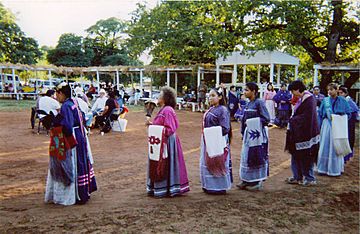
The Caddo creation story tells how their tribe came from a cave. This cave was called Chahkanina, or "the place of crying." It was located where the Red River of the South and Mississippi River meet. Their leader, named Moon, told the people not to look back. An old Caddo man carried a drum, a pipe, and fire. These items are still important in Caddo religion today. His wife carried corn and pumpkin seeds. As people and animals came out, a wolf looked back. This closed the exit, trapping the rest inside.
The Caddo people moved west along the Red River. They called it Bah'hatteno. A Caddo woman named Zacado taught the tribe how to hunt, fish, build homes, and make clothes. Caddo religion focuses on Kadhi háyuh, which means "Leader Above" or "Leader in the Sky." In old times, priests led the people. The head priest, called the xinesi, could talk with spirits near Caddo temples. Special ceremonies were held during important times of the year, especially for corn growing. Tobacco was also grown and used in ceremonies.
Caddo Lands and Neighbors
Many centuries before Europeans arrived, other tribes moved into some Caddo lands. These were the Osage, Ponca, Omaha, Quapaw, and Kaw tribes. They moved west around 1200 CE after fighting with the Haudenosaunee nations. The powerful Iroquois took control of hunting grounds in the Ohio River area.
The Osage especially fought the Caddo. They pushed the Caddo out of some areas and became strong in what is now Missouri, Arkansas, and eastern Kansas. These tribes had settled in their new lands before Europeans arrived in the mid-1700s.
Most Caddo people historically lived in the Piney Woods region of the United States. This area covers parts of East Texas, southern Arkansas, western Louisiana, and southeastern Oklahoma. The Piney Woods is a thick forest with rolling hills and wet areas called "bayous." Caddo people mainly settled near the Caddo River.
When they first met Europeans, the Caddo tribes were organized into three main groups. These were the Natchitoches, Hasinai, and Kadohadacho. They were also connected to other nearby tribes. The Natchitoches lived in northern Louisiana. The Haisinai lived in East Texas. The Kadohadacho lived near the border of Texas, Oklahoma, and Arkansas.
The Caddo people ate mostly crops they grew. These included maize (corn), sunflower, pumpkins, and squash. These foods were very important to their culture. They also hunted animals like wild turkeys and gathered wild plants.
Caddo Culture and Daily Life
The Caddo Native Americans had a culture based on hunting and gathering. Men hunted all year. Younger women gathered fruits, seeds, and vegetables for the tribe. Older women planted and cared for the crops. During warm seasons, they gathered corn, sunflowers, beans, melons, tobacco, and squash. In colder seasons, when crops didn't grow, they gathered acorns and roots for food.
Men used bows and arrows they made themselves. They hunted animals like wild turkey, quail, rabbits, bears, and bison in the winter. Women made most tools and items. They made wooden mortars and pots from clay. These tools helped with daily tasks like cooking. These tools were so important that men and women were buried with the items they had made.
The Caddo also decorated their bodies. Men liked body painting, jewelry, ear piercings, and hair decorations. They braided their hair and added bird feathers or animal fur. Women also wore some jewelry and styled their hair. But many women used tattoos to decorate their bodies. These tattoos often covered much of their body, including their face.
Caddo History with Europeans
The Caddo first met Europeans in 1541. This was when the Spanish Hernando de Soto Expedition traveled through their lands. De Soto's group had a fight with a Caddo band called the Tula people. This happened near what is now Caddo Gap, Arkansas.
The Spanish were seen as outsiders. Spanish missions were built far from the Caddo's temple centers. The Caddo did not want to move near the missions. They believed their own sacred fires were different from the Spanish fires. The Caddo also lived in spread-out settlements, which kept them safe for centuries.
French explorers came to northern Louisiana in the early 1700s. They met the Natchitoche Caddo. After them came fur traders from French areas along the Gulf Coast. Later, Catholic missionaries from France and Spain also visited the Caddo. The Europeans brought new infections like smallpox and measles. The Caddo people had no natural immunity to these diseases. Many Caddo died in epidemics. Influenza and malaria also caused many deaths.
French traders built trading posts near Caddo villages. These villages were already important places for trade among Native Americans. These trading posts attracted more French and other European settlers. Some modern towns like Elysian Fields, Nacogdoches, Texas, and Natchitoches, Louisiana grew from these early settlements. The early explorers kept the original Caddo names for these villages.
Over the years, the Caddo made peace with the Spanish, French, and later, American settlers. After the United States bought the Louisiana Purchase in 1803, the US government wanted to be friends with the Caddo. During the War of 1812, American generals fought against other Native American tribes. But the Caddo remained neutral and helped the US government with information. So, the US forces left them alone.
However, in 1830, the US government passed the Indian Removal Act. This law forced many tribes to move from the Southeast. This was so European-American settlers could take their land. In 1835, the Kadohadacho Caddo signed a treaty. They agreed to move to independent Mexico, which included Texas at the time.
In 1836, Anglo-Americans in Texas declared independence from Mexico. They formed the Republic of Texas. The name "Texas" comes from the Hasinai Caddo word táysha, meaning "friend."
In 1845, Texas became a US state. The US government then forced the Hasinai and Kadohadacho Caddo to move to the Brazos Reservation. White settlers wanted the Caddo to move even further north to Indian Territory. In 1858, white Texans attacked a Caddo camp. In 1859, many Caddo were moved to Indian Territory. After the Civil War, the Caddo lived on a reservation between the Washita and Canadian rivers in Indian Territory.
In the late 1800s, the Caddo adopted the Ghost Dance religion. This religion was popular among many Native American nations. John Wilson, a Caddo/Delaware medicine man, was an important Ghost Dance leader. He spoke only Caddo. People believed the dance would help them return to their old ways and stop European-American changes. In 1880, Wilson became a peyote roadman. The Caddo Nation is still very active in the Native American Church today.
From the Late 1800s to Today
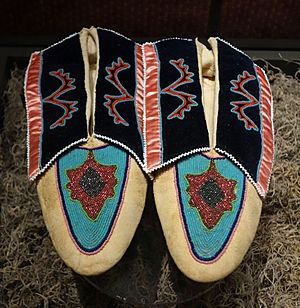
The US government passed the Dawes Act to change how tribes lived. This law broke up tribal lands into smaller pieces for individual families. Any land left over was sold, often to non-Native Americans. Tribal governments were also supposed to end. The Caddo strongly disagreed with this. A Caddo leader named Whitebread said they were "ignored and stuck away in a corner."
The Caddo and other Native American peoples suffered greatly from these changes. They lost much of their land and traditions.
Caddo Nation Reorganization
In the 1930s, new laws helped Native American tribes. The Indian Reorganization Act of 1934 and the Oklahoma Indian Welfare Act of 1936 allowed the Caddo to rebuild their government. They wrote a constitution and started electing leaders. They became the 'Caddo Indian Tribe of Oklahoma' in 1938. In 1976, they wrote a new constitution, which they still use today.
In the 1900s, Caddo leaders like Melford Williams and Mary Pat Francis helped guide the tribe. Mary Pat Francis was the first woman to be elected as tribal chair in the early 1980s. Her daughter, Tamara Michele Francis, was elected in 2015 and again in 2016.
In 2002, the tribe voted to add six changes to their constitution. To join the tribe, a person needs to show they have at least 1/16 Caddo ancestry.
Caddo Nation Today
Sometimes, there have been disagreements within the tribe. In 2013, a group tried to remove the chairman, Brenda Shemayme Edwards. This led to some difficulties in the tribal government. In 2014, a court ordered a new election for all positions.
In the January 2015 elections, women won all the top tribal positions. Tamara Michele Francis became chair, Carol D. Ross became vice chair, Jennifer Reeder became secretary, and Wildena G. Moffer became treasurer.
In July 2016, Tamara M. Francis was re-elected as Chairman. She is the daughter of Mary Pat Francis, the first elected female chairman. Tamara Francis is the fourth woman to lead the Caddo Nation.
Images for kids
Notable Caddo People
- T. C. Cannon, a famous Kiowa/Caddo painter and printmaker
- Raven Halfmoon, a talented sculptor and painter
- LaRue Parker, a tribal chairperson
- Jeri Redcorn, a Caddo/Potawatomi artist known for ceramics
- Louis Weller (1904–1979), a professional American football player
- John Wilson, an important Peyote roadman
See also
 In Spanish: Caddo para niños
In Spanish: Caddo para niños


